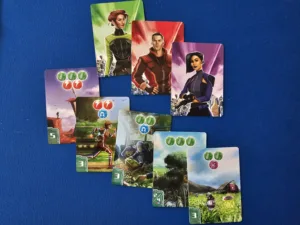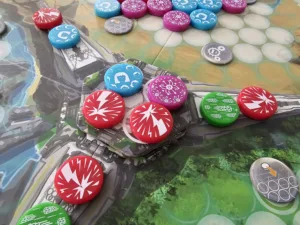 There is a long-standing policy at Board Game Quest Headquarters that states any game containing components that could be mistaken for candy has to be sent my way for review. It should come as no surprise to you then, Dear Readers, that the moment Neotopia landed at BGQHQ it was destined for my gaming table. A ton of chunky, colorful discs with interesting patterns adorning them? Delicious.
There is a long-standing policy at Board Game Quest Headquarters that states any game containing components that could be mistaken for candy has to be sent my way for review. It should come as no surprise to you then, Dear Readers, that the moment Neotopia landed at BGQHQ it was destined for my gaming table. A ton of chunky, colorful discs with interesting patterns adorning them? Delicious.
Culinary excellence aside: does Neotopia: The Game compare favorably to Neotopia: The Menu Item? Read on to find out!
Neotopia is a tile-placement, pattern-building game designed by Orlando Sa and Andre Santos for 2-4 players. The game breezes by and will likely be over before you know it in 40 minutes or so.
Gameplay Overview:
There aren’t many rules in Neotopia to speak of, so I won’t dwell too much in this section. The board is divided into three “regions,” each containing a series of spots for the aforementioned tasty discs. Players will score each of these regions separately by completing pattern cards once they can line up the discs in specific configurations.

On a player’s turn, they have the option of placing a tile into one of these regions from the board’s central “factory” (essentially a place where new tiles spawn randomly once they’re emptied). If this placement causes a match to a pattern on a card in their hand, they can score that card.
Players can also draw a new card instead, but only patterns a player completes themselves can score. There’s also a scoring quirk in which players can’t trigger the scoring of a pattern card in a region if the card type matches the one that was last scored. This is a weird rule to be honest; I suppose it might be a self-balancing attempt so the disc colors in the region become more varied, but it felt more like a stalling mechanism than anything else. (We also forgot to implement this rule a half dozen times.)
At the end of the game, players will earn bonus points for having a lot of their player-colored discs in each region and they will score points separately for each region, with the region they’ve scored the least in tripling in value. Whoever has the most points is the ruler of Neotopia (I think… I have no idea what the theme is here).

Game Experience:
One look at Neotopia set up and players will know what they’re in for. And that’s both a good thing and a bad thing. On the good side, all of the rules—save that weird scoring-type restriction—are very intuitive. Even the game’s way of giving out bonus actions to players when they hit certain spaces on the scoring track makes sense. (I didn’t go over these bonuses, but they are basically a free action once per turn with some altering the way players can grab a disc.)

The negative is that the game feels exactly like it’s comprised of leftover parts from other games. The contract fulfillment, such as it is, is very uninteresting and while there is a minor degree of tension about when to time tile placement or grab a card, players are often so spoiled for choice that there aren’t really any turns that seem to have meaningful decisions. Just balance out every region as best you can and you’ll probably be in contention.
The “market” of available colored discs seems like a fun design choice on its face, but in practice players can almost always find a way to get a disc they want into the region they want; there’s simply so many tiles available on every turn. Combine this with the fact that, for instance, the blue player will likely target blue discs more often, it makes the red player just focus on red stuff and so on.
As a minor aside: the game is beautiful and was clearly inspired in part by the esthetic of Azul. In some ways it feels like a similar attempt at mechanical design too; a way to sneak into the mass-market with a light tile-laying game with killer components. Sadly, this ain’t no Azul. (Grammar ftw.)
Final Thoughts:
Neotopia is a fair bit of fun for those in the mood for a pretty light and very fast-playing experience. There’s just not a lot of meat on the bones here. (That’s another food reference for those keeping track. I must be hungry.) About four turns into my first game, I decided I knew exactly how every turn of every game of this would play and repeat plays proved this to be an accurate assessment.
Final Score: 3 Stars – This score kinda leans toward 3.5 Stars to be fair. Neotopia is a solid and breezy tile-laying experience with neat components and one or two fun ideas.
 Hits:
Hits:
Incredibly fast-playing
Yummy looking (and tasting!) components
Intuitive rules
Misses:
Games tend to feel samey pretty quickly
Doesn’t necessarily scale well at lower player counts






















